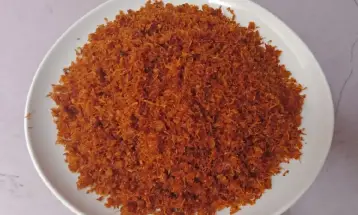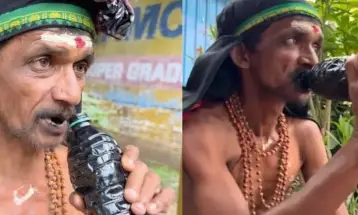Dulohupa Traditional House in Gorontalo

Holiday Ayo - Gorontalo has four traditional houses that are characteristic of Gorontalo province, namely the Dulohupa traditional house in the city of Gorontalo, the Bandayo Poboide traditional house in Limboto, the Ma'lihe or Potiwaluya traditional house and the last one is the Gobel traditional house in Bone Bolango.
Dulohupa Traditional house is located in Limba Village, South City District, Gorontalo City.
Dulohupa is also called Yiladia Dulohupa Lo Ulipu Hulondhalo by Gorontalo residents. This traditional house is in the form of a stilt house whose body is made of boards and a roof structure with the nuances of the Gorontalo area.
In addition, the Dulohupa traditional house is also equipped with wooden pillars as decorations and symbols of the Gorontalo traditional house and has two stairs on the left and right of the traditional house which are symbols of the traditional ladder or called Tolitihu.
The Dulohupa traditional house was built in the form of a house on stilts. This is done as a depiction of the human body, namely the roof depicts the head, the body of the house depicts the body, and the pillars supporting the house represent the legs. In addition, the form of the house on stilts was also chosen to avoid the occurrence of floods which at that time often occurred.

The Dulohupa traditional house in Gorontalo is built on principles and beliefs. The roof of the Dulohupa traditional house is made of the finest straw and is shaped like a saddle, which is a two-tiered triangular roof that depicts the Shari'a and customs of the people of Gorontalo. The upper roof illustrates the belief of the people of Gorontalo in God Almighty and religion is the main interest above others. While the lower roof illustrates the beliefs of the people of Gorontalo towards customs and culture. At the top of the roof, there used to be two logs mounted crosswise at the top of the roof or called Talapua.
The people of Gorontalo believe that Talapua can ward off evil spirits, but along with the development of Islamic belief, now Talapua is no longer installed.
On the front wall, there is Tange lo bu'ulu hanging next to the entrance of the Dulohupa traditional house. Tange lo bu'ulu describes the welfare of the people of Gorontalo. While the inside of the Dulohupa traditional house is open style because there are not many partitions. In addition, in the traditional house, there is a pavilion that is designated as a resting place for the king and the royal family.
Dulohupa has many wooden pillars. Apart from being support because the shape is in the form of a house on stilts, the pillars also have their own meaning.
In the Dulohupa House there are several types of pillars, namely, the main pillar or wolihi totaling 2 pieces, the front pillar totaling 6 pieces, and the base pillar or potu totaling 32 pieces.
The main pillar or wolihi is attached to the ground directly to the roof truss. This pillar is a symbol of the pledge of eternal unity and unity between the two brothers. 14 Gorontalo-Limboto (the promise of lou dulowo mohutato-Hulontalo-Limutu) in 1664. In addition, number 2 describes the delito (pattern) of adat and sharia as the principle of life for the people of Gorontalo in government and in everyday life.
Like the main pillar, the front pillar is also attached to the ground directly to the roof frame.
This pillar describes 6 main characteristics or characteristics of the people of Lou Dulowo Limo Lopahalaa, namely the nature of tinepo or tolerance, the nature of tombulao or respect, the nature of tombulu or devotion to the ruler, the nature of wuudu or according to fairness, the nature of adat or obedience to the rules, the nature of butoo or obedience to the law.
While the number of basic pillars or potu describes the 32 directions of the wind. In his time this pillar was devoted to the kings and nobles. The shape of the pillars on the front/porch is square in numbers 4, 6, or 8.

This illustrates the number of slaves owned by the king. But over time the number of pillars is still used even though it is not in a noble house and no longer describes a certain meaning.
In addition to the pillars, the number of steps in the Dulohupa traditional house also has its own meaning. The number of steps consists of 5-7 steps. Number 5 describes the pillars of Islam and the 5 philosophies of life for the people of Gorontalo, namely Bangusa talalo or protecting offspring, Lipu poduluwalo or perpetuating oneself to defend the country, and Batanga pomaya, Upango potombulu, Nyawa podungalo which means risking one's life to donate and sacrificing property.
While the number 7 describes 7 levels of lust in humans, namely anger, lauwamah, mulhimah, muthmainnah, rathiah, mardhiah, and kamilan.
Dulohupa is the local language of Gorontalo which means consensus or agreement.
In the past, this traditional house was used as a meeting place for the royal family and as a royal courtroom for traitors of the state through a three-stage government trial, namely Buwatulo Bala (security stage), Buwatulo Syara (Islamic law stage), and Bawatulo Adati (customary law stage) and planned regional development activities as well as solving the problems of local residents.
However, currently, the Dulohupa traditional house is used for performances of traditional ceremonies, such as traditional wedding ceremonies and cultural and artistic performances in Gorontalo. In this traditional house, there is equipment for wedding ceremonies, aisles, and other valuable objects.
In the Dulohupa traditional house, the traditional people of Gorontalo get married in the form of the aisle, traditional bridal attire, and other jewelry. Now the Doluhapa traditional house is used by the Gorontalo community to function as a place to carry out wedding ceremonies and other traditional ceremonies.








Leave a comment